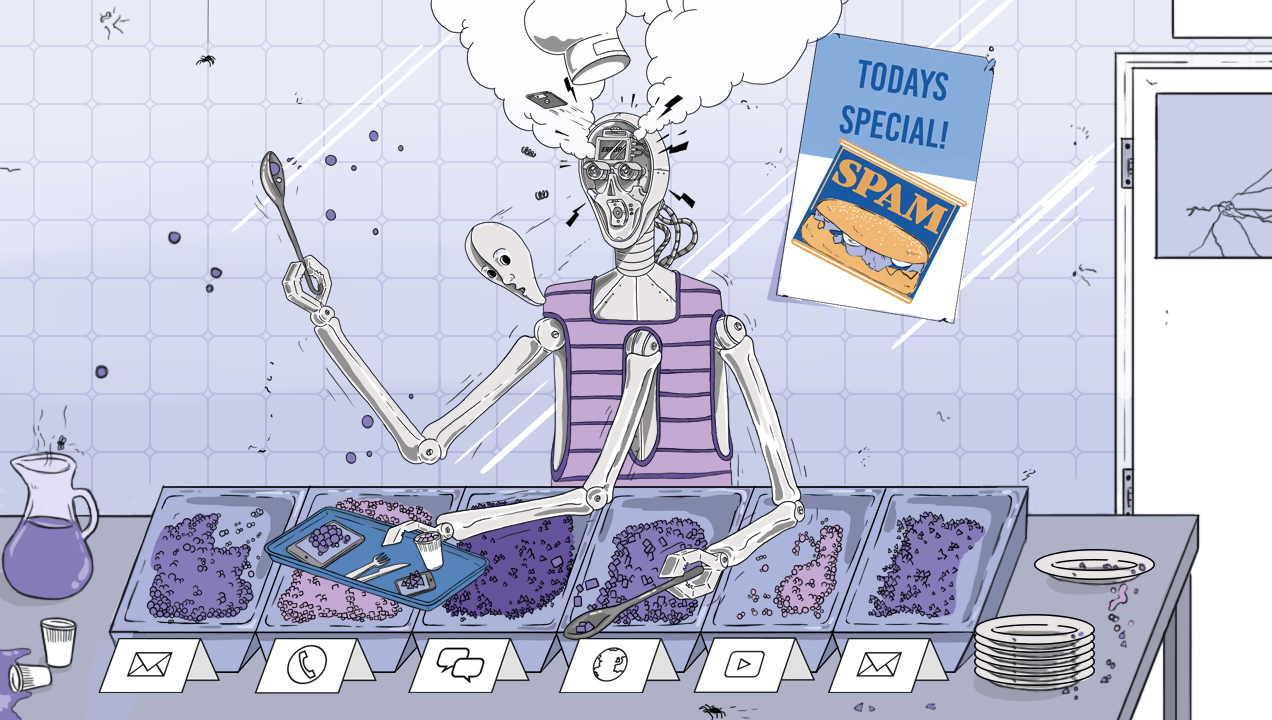Great CX vs the Omni-Spammer
Over the last few years most businesses have started to engage with customer experience (or CX) programmes, and one of the biggest changes on the customer service side is the evolution of the omnichannel contact centre. As the name implies, omnichannel systems supplement traditional phone-based customer support with tools that enable customer agents to answer queries and give support via whatever channel the customer uses, e.g. phone, SMS, social media, email and so on.
For companies that get it right, it’s a huge win, proven to increase lifetime revenues per customer, whilst increasing both brand loyalty and customer satisfaction. However when it’s badly implemented, it can create friction on the customer journey, and become the source of customer pain. Here’s some examples of typical omni-spam friction points for customers – drawn from the Labs team’s personal experiences – and potential solutions to fix the underlying problems that cause them.

All image credit: Jamie Blackett
The omni-spammer
Most people will recognize some (maybe all) of this scenario. It happens when a brand takes your phone number, email address and social media details, and then contacts you on all of them… with the same messages and customer survey questions. This is a tricky problem because the road to customer pain is paved with good omnichannel intentions…
- You get an email from customer services reminding you that your car is due for a service in a month’s time.
- The next day you get an SMS message reminding you that your car is due for a service in a month’s time.
- A week later get a second email, reminding you again. This time you click the link in the email and it takes you to a web page with a pop-up saying “your opinion counts, take part in our customer survey”.
- You close the customer survey box, then read the page…. Which asks you to call your local dealership to book a service.
- You decide to call it later because you’re too busy.
- Then you get another SMS.
- A day later, a letter arrives in the post, with a glossy A4 letter telling you that your car is due for a service, and to call and book a service.
- Then in the middle of a meeting at work, you get a call from customer services, asking you to book your car in for a service.
- As soon as the call ends, you get an SMS asking you to rate your telephone experience.
- Shortly afterwards, you get an email notifying you of the time and date of your service.
- Then you get an SMS notifying you of the time and date of your service.
- The week before your service visit, you get an email reminder.
- And an SMS reminder.
- Then the day before, you get a call from the service desk at the garage, checking you’re bringing the car in as arranged. You still are.
- On the day of the service, you call the garage to ask when your car will be available for collection, the main switchboard puts you through to the service desk, which doesn’t pick up.
- The service desk calls you hours later, saying the car is ready.
- As soon as you’ve picked it up, you get an SMS asking you to rate your service.
- And an email asking you to rate your service.
Okay, so this is an extreme example, but the problem with omni-spamming is simple: It shows that there’s a critical piece of information missing about the customer, i.e., their contact preferences.
Brands that understand the importance of customer preferences ask users how they would like to be contacted, and tailor push notifications to match. Of course, there is always the chance a customer ignores or misses a push notification on their preferred channel, so it’s actually a positive customer experience to add a reminder into the process, but there’s also a balance to be achieved. Too many notifications feels pushy, like a shop floor assistant following the you around “Can I help you with that?” every time you stop and look at something.
For companies that get it right, it’s a huge win, proven to increase lifetime revenues per customer, whilst increasing both brand loyalty and customer satisfaction.
How to avoid omni-spamming
Just because a customer can be contacted via SMS, email and phone, it doesn’t mean they weight each channel equally or want to be contacted on all of them. Also, they might choose different channels for different kinds of interaction, depending on how urgent their need is. Omnichannel availability is really effective for inbound communication to the brand – making customer services responsive in the channel the customer wants – but that doesn’t mean the customer wants to be treated like an omnichannel contact center when the brand decides to contact them.
The only way to design the right kind of omnichannel experience is to map the different types of customer journey, understand more about customer personas, and study customer behaviors to work out which channels are most useful for different categories of task, and which ones are overkill or just plain annoying.
Omnichannel needs an end-to-end process
Omnichannel systems transform the old call centre customer service model into an online version of the same, but the omnichannel part is only half of the process. The other half is delivering smarter, re-imagined user experiences to extract the full value from new digital channels. The goal is to enable end-to-end processes, because a channel has to lead somewhere, rather than become a customer dead end.
This means making sure that internal business processes (like workflow schedules and different departments) are joined-up where they intersect the same customer journey, sharing information and working more effectively in sync between business silos. It also means taking a close look at where these internal processes affect customer interactions on a channel-by-channel basis, and asking some fundamental questions, such as:
Does the customer have a contact preference?
Does the customer prefer to use a specific channel, or have they expressed a preference for frequency (e.g., did they check the “don’t spam me box” on their sign-up form).
Does the push channel have a return channel to enable an end-to-end process?
Does an email reminder link to an online self-service tool? Does a Facebook Messenger post link to a useful chatbot? Does an SMS have a reply function to enable an action? If the push channel doesn’t have a return channel (so it’s a one-way email, SMS, or social media message) is it clear what do do next for the user to complete a task?
Have you understood the customer intent behind information services?
If a customer has signed-up for information or alerts, it is usually to trigger an action, so does your omnichannel process enable actions, e.g., “Your train is delayed” is not as useful as “Your train is delayed, would you like to book an alternative route or get a refund?”
A contact centre agent is best used for complex queries, self-service is better for simple tasks.
A growing number of customers express a preference for self-service tools (usually online). Make sure there is a self-service option for simple tasks, like a web widget or chatbot that could deflect the need for customer calls. This frees-up customer agents to work on more complex customer interactions.
Does the contact agent have a rounded picture of the customer?
Are the agents calling someone who has already received two emails and an SMS and hasn’t responded, or are they receiving a call from someone who has emailed before, or posted on the brand’s Facebook page? Capturing the 360-degree view of each customer’s contact history helps the agent anticipate why the customer is calling, and helps them deliver a better level of customer service
Rethinking processes like this is the essence of modern CX design in the omnichannel era. It explains the value of studying customer journeys to understand the causes of customer frustration, and discovering the ways new systems can – sometimes – cause unexpected increases in customer effort.
The key to successful omnichannel implementation is to consider the big picture. In each customer contact scenario, the omnichannel platform works most effectively if it’s integrated into a new contact process that uses the strengths of each channel to deliver an end-to-end experience.
The future isn’t channel-centric, it’s human-centric
The key to successful omnichannel implementation is to consider the big picture. In each customer contact scenario, the omnichannel platform works most effectively if it’s integrated into a new contact process that uses the strengths of each channel to deliver an end-to-end experience. Each channel is different, and presents a complex set of possible next-best actions, so it’s important to really understand your users and their preferences to offer relevant, personalized customer experiences. Regardless of how many channels your customers use, and how diverse their preferences are, they all want the same thing, an easy, intuitive customer experience. A deep understanding of the customer, and designing processes around them, is what makes the difference between omni-spam and great omnichannel customer service.
